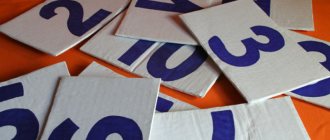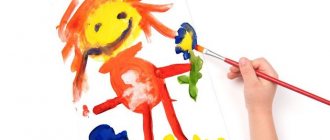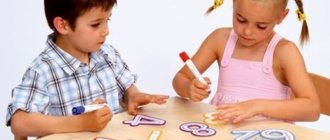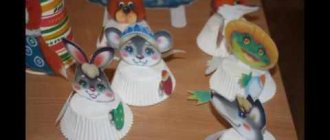Counting is one of the basic skills that it is advisable to master before the child goes to school. No one will require a first-grader to solve complex examples - but learning to count the number of objects and knowing the basics of addition and subtraction before school will be useful. The child will not have difficulty understanding the teacher’s requests - for example, “take two pencils” - and the first grader will not feel less smart than peers who have already learned to count.
When sending your child to school, take care not only of his intellectual preparation. After all, at school the child will encounter a whole new world. Some children have a hard time with the adaptation period. The “Where are my children” application will help you make sure that your child is not bullied by peers or teachers, that he has no problems and that he is safe!
There are many ways to teach a child to count: using methods developed by professional teachers, in a playful way, using rhymes and thematic videos. Whichever method you choose, learning to count can be considered the first step to learning mathematics. A good knowledge of mathematics is the key to not only positive grades, but also excellent memory and attention, developed logical thinking, and the ability to calculate the right decision in any situation.
First acquaintance with numbers: when and where to start
You can start introducing your baby to numbers at the age of 1.5-2 years. But it is too early to expect significant mathematical success from a small child, although children quickly understand the difference between the concepts of “one” and “many” even at an early age.
Briefly about the stages of a child learning to count - in the table:
Trying to teach a child to count too early is not worth it because of the differences in children's thinking from that of adults. There is such a thing as Piagetian phenomena, proven by the French psychologist Jean Piaget.
The psychologist has proven that children under six years old cannot treat counting abstractly, considering a mathematical operation to be correct only in the present tense and precisely with those objects that an adult shows. For example, a child under six years old will be convinced that if he takes the apples to another room, or replaces the apples with pears, the number of objects will change.
The best way to teach children to count is in 4 stages:
- At 2-3 years old it is enough to teach a child to understand the difference between “little” and “many”.
- At 4-5 years old, it’s time to learn to count concrete, not abstract, objects within 10: candy in a vase, plates on the table, books on a shelf.
- At 5-6 years old, a child can be taught to count to 10 and 20, and show how numbers look and are written. At the same age, the baby is already able to understand the terms “more and less,” adding the right amount to objects or, conversely, removing the excess to achieve equality (for example, arranging toys in equal piles).
- By the age of 6-7 years, the child is ready to learn to count to 100, and add and subtract numbers up to 10.
When?
The question of when children should start learning to count still causes controversy and disagreement. The gurus of pedagogy and psychology are divided into two irreconcilable camps.
Some of them believe that a child, reaching 2-3 years of age, enters a time of maximum interest in everything new and unknown. It is at this time that they are ready to begin learning, willingly accept everything new and absorb knowledge like sponges.
However, opponents also have strong arguments in favor of early education. Starting from 6 months, the child is actively learning to speak, adopting basic social skills, which means he is capable of learning. This is precisely what all early development methods are based on, which, by the way, give excellent results!
So when should you start training in order to achieve results and not instill in your child aversion to all learning activities? Exactly when your child is ready for such training. Who, if not parents, understands and feels their baby? Once you start using early learning techniques, you can take a break from your studies after a short time and analyze the information you already have. Whether he shows interest, whether he likes the classes, whether they produce results, all this must be used to decide whether to continue them or, on the contrary, stop them.
Photo source: shutterstock.com
How to teach counting to 10
You can teach your child to count to 10 before the age of five, or, if necessary, at an older age. The main conditions for successfully teaching mental counting to 10 are a child’s good vocabulary and interest in numbers.
How to teach your child to count to 10:
- focus on numbers that you already use in everyday situations, for example: “You are four years old now, and will soon be five years old,” “It’s time to get up, it’s already seven o’clock”;
- show images with different numbers of objects within 10: illustrations in books, cubes, your own drawings;
- educational videos and cartoons on the relevant topic will help you quickly remember the sequence of counting to 10;
- connect elements of mental arithmetic: teach your child to use an abacus - often children quickly master counting within 10 by practicing with abacus abacus, or even with classic wooden abacus;
- use an element of the Montessori method: the famous teacher successfully taught counting to children aged 3-6 years, regardless of their initial abilities, using the most visual practical material - money (Maria Montessori considered money exchange exercises to be the most effective activity for understanding counting).
When sending your child to school, take care not only of his intellectual preparation. After all, at school the child will encounter a whole new world. Some children have a hard time with the adaptation period. The “Where are my children” application will help you make sure that your child is not bullied by peers or teachers, that he has no problems and that he is safe!
How to teach counting to 20
You can teach your child to count to 20 when he can confidently count to 10. To quickly and easily master counting to 20, proceed in the following sequence:
- Tell your child what zero is (if he doesn’t already know) using visual examples. For example, show two books or two other identical objects, and then remove them. Explain that there were two books, and now there are zero.
- Show how new numbers are formed - it will be easier for the child to understand the principle using the example of numbers ending in zero. Tell us that in Old Russian “dtsat” means ten and, accordingly, the number 20 is two tens (you need to count to ten twice).
- Introduce your child to the concept of “number composition” - also with the help of improvised objects: counting sticks, toys, fruits. Place 10 identical objects in one row, and on top place an object different from these ten, for example, a counting stick of a different color. Explain to your child that the number is eleven. By adding sticks on top, show how you get 12, 13, 14, and the rest of the numbers up to 20.
- Give your child the task of collecting a certain number of identical objects (16, 17, 18, etc.), for example, small toys, and together count the number of objects out loud.
- Reinforce the material using a number line from 0 to 20 - this way your child will learn to count to 20 much faster. You can draw a number line yourself or use a ruler 20 centimeters long. By practicing with a ruler, the baby will gradually remember how to write numbers and their correct sequence.
At what age can you start teaching children to count?
Natalya Melnichuk, director, educational psychologist of children's development programs (Simferopol):
— We teach counting to children from the age of two. We study counting by playing various games using counting material. The counting material can be anything: capsules from Kinder surprises, various wooden or plastic figures, balls. Active musical games aimed at collecting the required number of objects work very well.
In fact, even a one-year-old toddler can remember numbers. It is enough to regularly show him a visual designation of a number throughout the day and say its name out loud. When the baby begins to speak, he will be able to reproduce the words heard in the cradle and associate them with the image of a specific sign.
At the age of 3-5 years, play becomes the main form of activity. She helps the baby learn numbers and count, find out the number and determine the number of objects.
How to teach counting to 100
When a child learns to count to 20 without missing a beat, it’s time for parents to help their son or daughter master counting to one hundred. Try teaching your child to count to 100 this way:
- Tell your child that numbers greater than ten used to be called “two tens,” “three tens,” “four tens,” and so on. Later, the word “ten” was shortened to “twenty” and the familiar “twenty”, “thirty”, “fifty” appeared. Exceptions to remember: "forty" (meaning "very many") and "ninety" (meaning "nine to a hundred").
- Practice memorizing tens in the correct order from 10 to 100: 10, 20, 30, 40, 50...
- Once you remember the correct sequence of tens, move on to units. Explain to your child that the numbers from 20 to 100 are not consecutive - there are always ones between them: 21, 22, 23, etc. Children who have mastered counting to 10 and 20 quickly understand and remember the sequence of counting to one hundred.
- Ask your child to learn numbers gradually, one ten a day: from 10 to 20, from 20 to 30, and so on in order until 100.
- Practice activities in game forms. Encourage children's love to look for inconsistencies and errors: deliberately skip a number in a series up to 100, and ask the child to find the “missing” number - such logic games help to quickly memorize counting up to 100.
Having mastered the numbers, proceed to gradually study the multiplication table. We have collected in one place and talked about the most effective ways that will help your child easily cope with this task!
Learning numbers with preschoolers for younger and middle ages
Learning numbers with preschoolers for younger and middle ages
Goal: fix the score within 5.
Tasks: Familiarize yourself with numbers from 0 to 5.
Develop a sense of love for nature.
I would like to present my work (Video “Learning numbers”, where I tried to attract children’s attention to objects of living and inanimate nature. Children can easily watch a ladybug in a playful way. Which symbolizes an object of living nature (bees, frogs, turtles).
Addition and Subtraction: Effective Ways to Learn
By the time they start school, most children already know how to operate basic math operations—addition and subtraction. The modern program for the first grades is structured in such a way that children are given addition and subtraction problems almost immediately - and it is better to learn to add and subtract in preschool age.
How to teach a child addition and subtraction: first steps
Start getting acquainted with basic mathematical operations by using visual objects - cubes, counting sticks or others convenient for the child:
- disassemble the number 2: show the child that if you add one object and another object, you get 2;
- in the same way, sort out the composition of the remaining numbers within 10;
- make sure that the child understands the principle of disassembly and puts objects together without errors;
- Having mastered addition, move on to subtraction using the same visual objects.
Addition and subtraction on fingers
When your child learns to add and subtract objects, move on to adding and subtracting on your fingers - or skip this stage if your son or daughter quickly and confidently adds and subtracts all surrounding objects. In any case, make sure that your child gradually weanes himself from counting on his fingers - teachers notice that the habit of counting on his fingers prevents children from learning to count in their heads.
How to teach your child to count on fingers:
- Start with the five fingers of one hand, coming up with interesting puzzles for your baby. For example, an addition problem: “You have 2 cars, so straighten two fingers. My brother has 3 cars, stretch three more fingers. You have a total of 5 cars."
- Offer to solve subtraction problems. For example: “Mom has 4 candies, stretch out four fingers. Mom gave you one candy, bend one finger. Mom has 3 candies left.”
- When the child begins to add and subtract within five without errors, move on to similar activities involving all ten fingers.
How to teach a child to count in his head
The ability to add and subtract mentally is one of the most useful skills for a preschooler, which will greatly facilitate the study of mathematics at school. Before teaching your child to count in his head, make sure he knows how to add and subtract objects and can count at least within twenty.
How to teach a child to count in his head:
- Create a clear connection in your child between number and visual image: connect games with mathematical dominoes and cubes. You can use a mathematical set using the Zaitsev method: a set of cards that connects a number and a geometric figure. Children respond well to lessons using Zaitsev’s method - gradually this way they can learn addition and subtraction even within a thousand.
- Teach your child, if he doesn’t yet know, what “more”, “less”, “equally” means, using visual examples.
- Spend enough time parsing the number. To add 4 and 3, a child must know that these numbers “fit” into the number 7. The same principle works with subtraction: in order to subtract 5 from 8, you need to know that 5 and 3 “fit” into 8.
- Introduce your child to the rule “the sum does not change by changing the places of the terms.”
- Include any gaming aids that your child likes: cubes, tables, counting sticks, cards, themed board games.
How to teach a child to count backwards
If a child can count to one hundred and understands well what units and tens are, there are usually no difficulties with counting in columns.
How to teach a child to count in a column:
- Explain that numbers in a column are added and subtracted by digits: units - separately, tens - separately.
- Show the sequence of actions if, when adding units, the result is a number greater than or equal to 10: you need to write down only the second digit, and remember the first. For convenience, the first resulting digit can be written above the tens place. Parents probably remember from their school days the expression: “We write two, one in our minds” (or other numbers from 0 to 9). Example: 17+15 = 7+5 = 12 (a two is written, a one goes to the tens) = 1+1+1 = 3 (the total sum of the tens place) = 32 (the first digit is the sum of the tens place, the second digit is the sum of the ones place ).
- Teach your child to subtract columnarly. The principle of operation is almost the same as with addition, only if the upper digit in units is less than the lower one, then the missing unit must be “borrowed” from tens. For example: 31-13 = 11-3 = 8 (“occupied” the number 1 from the tens) = 2-1 = 1 (the number 3 in the tens decreased by the “occupied” unit) = 18.
Methods for teaching counting created by famous teachers
Try using one or more effective pedagogical techniques to study counting:
Peterson
The Peterson method teaches children mathematics exclusively in a playful way: with the help of cubes, drawing, and logic games.
Glen Doman
Glen Doman's method is entirely based on visualization: children see numbers on cards and the number of dots corresponding to the numbers, gradually mastering counting:
- Prepare cards from cardboard: write a number on one side, and draw the number of dots corresponding to this number on the other.
- Show your child a card with one dot and clearly state the number “One.”
- Move on to other cards using the same pattern. Don’t delay - one card should take as much time as it takes to pronounce a certain number.
During the first few lessons, the child can act as an observer. Don't ask him to repeat it. After showing all the cards (10, 20 numbers depending on age), be sure to praise the baby, tell him how much you love him and how you like to teach him. You can treat your future mathematician to something tasty, since physical encouragement is an integral part of Glen Doman’s method.
From lesson 3-4, you can start shuffling the cards, that is, showing them not in a clear numerical order. Remember the main thing: we show quickly, we praise generously.
Mental arithmetic
Children learn to count using dominoes, and later immediately begin to count in their heads without using an abacus or any other tools.






